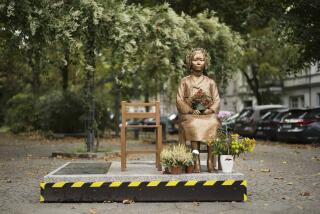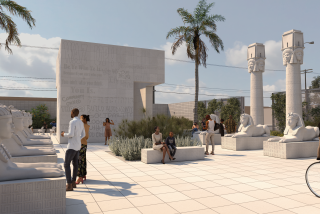A Grand Design for Nazi Camp
- Share via
ORANIENBURG, Germany — For nearly half a century, this town just north of Berlin was notable for little besides its sprawling East German National People’s Army base, its badly polluted soil and its memorial to the victims of the Nazis, laid out in a small triangular yard where the barracks of the Sachsenhausen concentration camp once stood.
Today, however, because of a bold proposal by a UCLA architecture professor, Oranienburg stands reluctantly at the center of a broad discussion in Germany over how, since East and West have been reunited, to best remember the crimes of the Nazis. Should future generations be reminded and instructed through the careful preservation of historic places like Sachsenhausen? Or might it be better, perhaps, to do so through well-chosen monuments and works of art?
Or, for that matter, should modern, democratic Germany even be dwelling on its past anymore? Must remembrance and atonement go on forever?
The man who has dragged Oranienburg into the heart of this touchy debate is Daniel Libeskind, a tenured professor at UCLA who now makes Berlin his primary workplace. His original proposal to flood a vast swath of the campsite to create a “sunken architectural zone” astounded, astonished and enraged many Germans.
In November, after lengthy public arguments, Libeskind finally won a commission to renovate a large part of Sachsenhausen. It was one of Nazi Germany’s most notorious concentration camps, but after years of neglect, what is still standing is fast falling into ruin.
Libeskind--a Polish-born Jew, Israeli-trained musical prodigy, mathematician-philosopher and deconstructionist architect--is clearly going for the art-as-remembrance option.
Known for bold designs aspiring to connect the physical world with the highest levels of abstraction, Libeskind created a wild collection of angles and voids for the much-discussed new Berlin Jewish Museum, his attempt to embody loss and German-Jewish history.
Not for him a traditional memorial at Sachsenhausen tucked away in the Prussian boondocks.
Sachsenhausen “is a site which has a critically important European significance,” he wrote in his original proposal. “What must be faced, in any endeavor to re-create and redevelop such an area, is the need to mourn an irretrievable destiny and a hope that this mourning will affect the political program, social use and their connection to the topography.”
So far, so good.
But Libeskind proposed to do this by knocking down the rotting camp buildings, flooding the land and inviting visitors to walk across the water on dikes, from which one could contemplate his sunken architectural zone. By viewing the submerged foundations of the Nazis’ “ideal City of Death,” Libeskind proposed, the visitor might receive “a new baptism.”
Right.
Architect’s Proposals Spawn Indignation
Instead of baptism and redemption, Libeskind’s astonishing proposals for Sachsenhausen brought cries of indignation. His opponents have included historic preservationists, who say Sachsenhausen’s unique remnants of the Holocaust should be maintained, not demolished and turned into art, and the good burghers of Oranienburg, many of whom would be happier if the former konzentrationslager were not refurbished at all but simply allowed to complete its passage to nothingness.
At the same time, however, Libeskind’s avant-garde proposals have fired the imaginations of some German intellectuals, ever on the lookout for new ways of learning from, and dealing with, the dreadful unbelievability of their country’s past.
And as the discussion over what to do with the ruins of Sachsenhausen has gone forward--and as Libeskind has dropped some of the more provocative elements of his design--the architect has won extensive public support, even from his former opponents.
“This has been a learning process,” admits Guenter Morsch, director of the Brandenburg Memorials Foundation, a state body whose mission includes protecting and preserving as much of Sachsenhausen as possible. At the beginning, Morsch was one of Libeskind’s principal foes.
“We’ve had different points of view, but we’re coming closer together,” he says. “If our foundation can find a way to cooperate with Mr. Libeskind, then there is a chance, for the first time in Germany, to show with the help of a good architect how to deal with a zone of criminality. And we’re close to that.
“But,” he adds, “it’s just too much for a little town of 28,000 to deal with.”
Oranienburg Officials Get the Big Picture
Certainly, Oranienburg officialdom had no idea what would happen when the town invited half a dozen architects to submit designs for 8,000 units of housing--plus kindergartens, sports fields, municipal offices and other suburban impedimenta--on land just across from the barbed-wire fences of Sachsenhausen’s wind-swept roll-call yard.
It was 1992, the Berlin Wall was being ground up for use as road surfacing, and foremost in the minds of most Oranienburg residents was that 45 years of Communist-imposed poverty was finally over and it was time to get down to the agreeable business of building some decent housing.
Sachsenhausen, to most people living nearby, was just the memorial site: a patch of land inside an old, triangular perimeter wall, marked off by a guard tower, a little museum and a tall, contemporary sculpture evoking a crematory chimney. It was one of those places to which, duty-bound, you had to journey with your schoolmates.
What the people of Oranienburg had forgotten was that the real Sachsenhausen was exponentially bigger than what meets the eye today. It once sprawled over more than 960 acres--about a quarter of the town--and included whole neighborhoods of cozy houses for SS guards, cavernous warehouses, a brick works once staffed by forced labor, a rifle range where Gypsies and homosexuals were once used as human targets. There was even a canal system and a small port. The triangular remnant is but 5% of the total area.
And while Sachsenhausen may not have the infamous ring of Auschwitz, the facility was one of the Nazi period’s most demonic penal camps. Built in 1936 on the order of Gestapo chief Heinrich Himmler, it was intended as a model for other such sites to come--”a modern and progressive concentration camp,” as Himmler put it--and as the home office for Adolf Hitler’s entire concentration camp system. Not a single pencil was ordered, not a canister of Zyklon-B gas procured, without the paperwork coming through the in-out baskets of Sachsenhausen.
“The problem is, no one knew this anymore,” says Christian Kielczynski, Oranienburg’s head of city planning.
How could people forget? The answer has much to do with the East German take on history, which held that Nazi criminality sprang directly from the capitalist system, not from the banal, collaborative activities of countless ordinary people.
“East Germany wasn’t about to discuss what really happened here,” architect Libeskind says. “They just took themselves out of history and said, ‘We are the good Germans, and we never had anything to do with the other [West] Germans.’ ”
Communist East Germany set about putting Sachsenhausen’s land and buildings to practical use. Only under pressure from former inmates did the state preserve the triangular roll-call yard and barracks area as a monument. The rest was converted to use, first as a prison and later as a base for the army. Tanks careened about the bone fields of the dead on Warsaw Pact exercises; ordinary citizens moved into the vacated houses of the SS guards.
When Libeskind received an invitation to “urbanize” this site even further, he couldn’t believe it.
“After I studied the brief, I said: ‘This is impossible! Just to erase this? It’s a mad idea,’ ” he remembers.
Instead of designing new housing, Libeskind delved into the original plans for Sachsenhausen, trying to get some hold on what they said about the fascist mind at work.
“Of course there was symbolism,” he says. “This was their cosmological model of how to exterminate populations.”
Plan Includes Razing an Embodiment of Evil
Libeskind decided that his artistic goal would be not to “urbanize” the area but to ritualistically destroy this architectural embodiment of evil. He proposed doing this by tearing down the Nazis’ buildings and flooding half the land for his sunken architectural zone.
Then, on the remaining dry ground, he would build a long, bar-shaped building, oriented at an odd angle that would spoil the perfect symmetry of the Nazi design. He called this building a “Hope Incision” because it would house training centers for the unemployed, clubs for the young, a library, a museum, an ecumenical chapel, mental-health clinics and other beneficial public services.
But no housing.
“This program [envisioned by the city] quite emphatically rejects trivializing the site [by] placing housing on it,” he wrote.
“Of course, I was disqualified,” Libeskind says with a laugh.
The panel of judges gave first prize to the plans of an Austrian architect who followed the competition instructions and designed a normal, attractive neighborhood of apartment buildings and free-standing houses.
But the judges did give Libeskind an honorable mention, and this recognition was enough to keep his arguments alive--and to force the people of Oranienburg to confront their own hidden history. Was it really fitting to build apartments on an old concentration camp? Should the city really be wooing investors to build shops and factories on land containing the bones of the victims?
Most emphatically yes, said some, particularly those living in the snug, cottage-like houses originally built for the SS guards. They saw in Libeskind an interloper who could not possibly understand how much East Germans had suffered during the Communist years and who now had the audacity to stand in their way when they tried, at long last, to do something good for themselves.
Preservationists Have Divided Reaction
Historic preservationists, meanwhile, were pleased that Libeskind did not want to build apartment buildings--but they were horrified by what he wanted to do instead.
“Libeskind’s design had nothing to do with what happened here,” argues Morsch of the Brandenburg Memorials Foundation.
“The problem is, there is such a gap between the terror of the Nazi dictatorship and the banality of the Nazis’ buildings that artists always feel compelled to fill this gap with art,” he says.
In 1994, the city of Oranienburg took a stand: The mayor thanked the Austrian architect who had won the competition but announced that Oranienburg would not be using his design after all. A long period of debate over what to do instead followed, with public forums, seminars, lectures and newspaper columns.
Some townspeople warmed to the thought that a big work of conceptual art, by a famous architect, might attract visitors and enhance local prosperity. Even some historic preservationists came around because they realized that without any agreed-upon course of action, Sachsenhausen would simply disintegrate.
“This clash has been going on for years, and meanwhile, the buildings are falling to pieces,” Morsch says. “We have a word in German for this process: [translating as] ‘cold demolition.’ In other words, you don’t destroy the buildings on purpose, you just let them rot.
“We historians want to have all our documentation, and if we get it, then we are content,” he adds. “But maybe, for normal people, that’s not enough. Maybe they need some works of art too.”
Art and History Can Coexist at Camp Site
In this spirit of compromise, an agreement was finally reached last year: Historic preservation and artistic provocation were not mutually exclusive; they could co-exist at Sachsenhausen.
Now Libeskind is working on his final plans for Sachsenhausen, specifying which of the Nazis’ tumbledown buildings are to be demolished, which should be restored, what new artistic elements should be built and what, exactly, the Hope Incision building will look like.
He has dropped his radical sunken architectural zone. If any baptism is to be achieved here in the future, it will be through the use of waters flowing demurely through a system of artistically placed canals.
“This is a strange fate,” Libeskind says of his role in the Sachsenhausen affair. “It was only by chance that I was invited to do this project. And I must say, I will never again be asked to do anything by the state of Brandenburg. But if I had not been invited, today there would be a huge, 8,000-unit housing estate on this site, with bus lines running through it.”
More to Read
The biggest entertainment stories
Get our big stories about Hollywood, film, television, music, arts, culture and more right in your inbox as soon as they publish.
You may occasionally receive promotional content from the Los Angeles Times.










